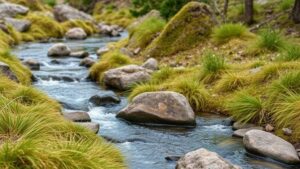Filing Claims for Alluvial and Bench Deposits Along Rivers
Filing Claims for Alluvial and Bench Deposits Along Rivers
Alluvial and bench deposits are critical sources of minerals, including gold and other precious metals, found near riverbanks. Understanding the processes and regulations surrounding filing claims for these deposits is essential for miners and those interested in resource extraction. This article explores the key elements involved in filing claims for alluvial and bench deposits, including legal frameworks, processes, and practical considerations.
Understanding Alluvial and Bench Deposits
Alluvial deposits are materials deposited by flowing water, typically found in riverbeds, floodplains, and deltas. e deposits often contain valuable minerals that have been eroded from surrounding rocks and transported downstream. Bench deposits, on the other hand, represent elevated areas adjacent to rivers formed through historical river activity, often featuring layers of sediment enriched with minerals.
According to the U.S. Geological Survey (USGS), alluvial gold contributes significantly to mining yields in regions such as California and Alaska, highlighting the importance of understanding these deposits for potential extraction.
Legal Framework for Mining Claims
Filing claims for alluvial and bench deposits is governed by various local, state, and federal regulations. In the United States, the Mining Law of 1872 allows individuals and companies to stake claims on public lands for mineral exploration and extraction, provided they follow necessary procedures.
- Locating Claims: Miners must first locate an appropriate section of land that contains the desired deposits. This often involves researching geological maps and physical site assessments.
- Filing with Authorities: Once a location is identified, miners typically file a claim with the Bureau of Land Management (BLM) or corresponding state agencies. This filing includes submitting forms, maps, and possibly fees.
Process of Filing Claims
The process for filing claims can generally be broken down into several steps:
- Research: Ensure that the chosen area is open for mining. This includes checking for existing claims and understanding the laws that apply to specific regions.
- Determine Claim Type: Claims can be for placer mining (deposits of sand and gravel) or lode mining (extracted minerals). Each type has different requirements.
- Claim Staking: Physically mark the boundaries of the claim on the ground with stakes. This serves as a visual indication and legal boundary for ownership.
- Filing Paperwork: Submit the required paperwork to the BLM or state authorities, which may include proof of discovery and the claims size and boundaries. Fees vary by state but can be upwards of $100.
- Annual Maintenance: Once a claim is established, miners must file annual maintenance fees and demonstrate ongoing work to keep the claim active.
Challenges and Considerations
While the potential for resource extraction from alluvial and bench deposits can be lucrative, several challenges must be considered:
- Environmental Regulations: Miners are often required to comply with environmental assessments and protections. This can involve evaluating the impact on local ecosystems and waterways.
- Legal Disputes: Claim disputes can arise between miners or with landowners. Establishing clear boundaries and maintaining proper filings is crucial to avoid legal issues.
- Market Fluctuations: The value of minerals can change based on market demand, impacting the economic viability of a claim.
Case Studies and Real-World Applications
A practical example of successful claim filing can be drawn from the Klondike Gold Rush, where miners effectively utilized methods to file claims for alluvial gold deposits. Today, similar methods reflect a structured approach to claim filing and extraction.
In modern instances, companies such as Gold Mining Inc. have navigated the intricate process of filing claims successfully, leading to significant finds. They exemplify the importance of thorough research, compliance with legal requirements, and ongoing maintenance of claims.
Actionable Takeaways
For those interested in filing claims for alluvial and bench deposits, consider the following actionable steps:
- Conduct comprehensive research on the areas of interest, ensuring that theyre available for mining.
- Understand the legal framework and documentation requirements, including environmental assessments.
- Be prepared to maintain claims through ongoing fees and work commitments.
- Consult with legal and mining professionals to navigate the complexities of the mining landscape effectively.
The process of filing claims for alluvial and bench deposits can be both rewarding and complex. By understanding the requirements and challenges presented, aspiring miners can position themselves for success in this competitive field.
